
The Fabulous Mid-Century Modern Architecture in Palm Springs
Flashback to Palm Springs in the 40’s, 50’s and 60’s and what do you find? A playground for movie stars and hundreds of homes, offices and other buildings in an architectural style now called mid-century modern or desert modern. Famous architects left their mark forever on Palm Springs with this modern style known for lots of glass, sleek lines, integration with nature, and living spaces perfect for an indoor/outdoor lifestyle.
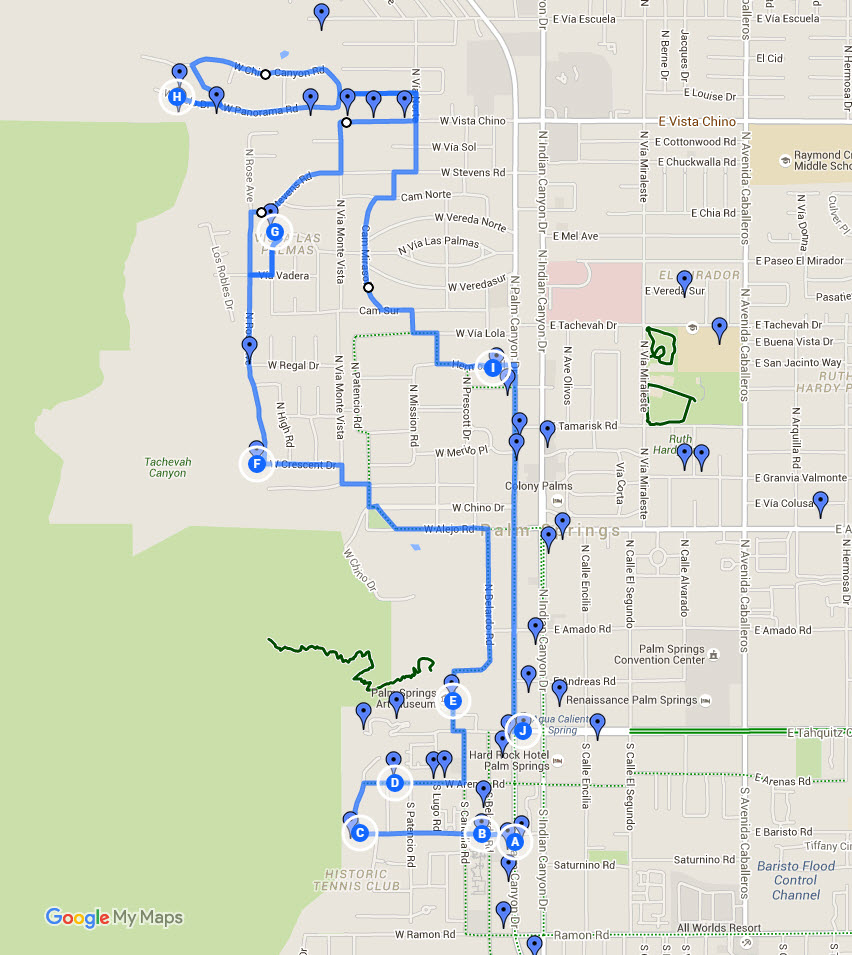
Modern Tour Bike Route Map – a 7 mile loop
Biking is a lot of fun in Palm Springs – it’s mostly flat, there are dedicated bike lanes through calm neighborhoods, and best of all – you get to see some great mid-century modern architecture along the way.
The Architects
If you’re curious about the famous architects whose buildings you ride by on this bike route, these are the names you’ll want to know – Frey, Neutra, Williams, Krisel, Cody. Want a little more info? Here’s a little primer:
1.) Albert Frey – developed the style known as desert modernism. Designed over 200 projects in Palm Springs. Born in Zurich, he lived in Palm Springs from 1934 until his death in 1998 at the age of 95.
2.) Richard Neutra – Born in Vienna, he moved to the US and became a citizen in 1929. He designed over 300 homes in California, returned to Europe around 1960 and lived in Germany until his death at age 78. Fans of novelist Ayn Rand will be interested to know that she based part of the Howard Roark character in The Fountainhead on Neutra.
3.) E. Stewart Williams – Joined his architect father in Palm Springs after serving in WWII. Designed mostly commercial projects in Palm Springs, including the Palm Springs Art Museum. Born in Dayton Ohio, he lived in Palm Springs until his death in 2005 at age 96.
4.) William Krisel – Born in Shanghai China to American parents, the family moved to Beverly Hills when he was 13. Krisel and his partner Palmer designed tract homes throughout Southern California, in Palm Springs he collaborated with Anderson Construction Company and built thousands of tract homes that still exist today.
5.) William F. Cody – Cody’s family moved from Dayton Ohio to Southern California when he was 14. His first independent commission was to complete the Del Marcos Hotel. He moved his practice to Palm Springs and designed all types of buidings in the Coachella Valley.
Julius Shulman, Palm Springs Photography
Julius Shulman, 1910-2009, was an active architectural photographer from 1936 until 1986. His legendary photography of the Palm Springs modern architecture played a major role in creating the image of the Southern California Lifestyle. Doesn’t everyone want a peek into the interiors of these famous places? The closest most of us will get are the Shulman photos in the Getty archive, which are free to use with credit to © J. Paul Getty Trust. Getty Research Institute, Los Angeles (2004.R.10).
Biking Your Own Modern Tour
A fitting place to start biking a mid-century modern tour is at the Palm Springs Architecture and Design Center in downtown Palm Springs. From there, head west for a spin through the Tennis Club Neighborhood, then over to meander through the Las Palmas and Vista Chino neighborhoods for a look some of the most famous mid-century moderns in these areas.
Palm Springs Architecture and Design Center, 300 S. Palm Canyon Drive
Designed by E. Stewart Williams, this beautiful building was originally the Santa Fe Federal Savings & Loan building, completed in 1961. The human-scale glass pavilion has a cantilevered floor slab giving the illusion that the building floats over the ground. The wraparound glass walls are shaded with protective patterned screens, a feature you’ll find throughout desert modern to protect from the intense sun.
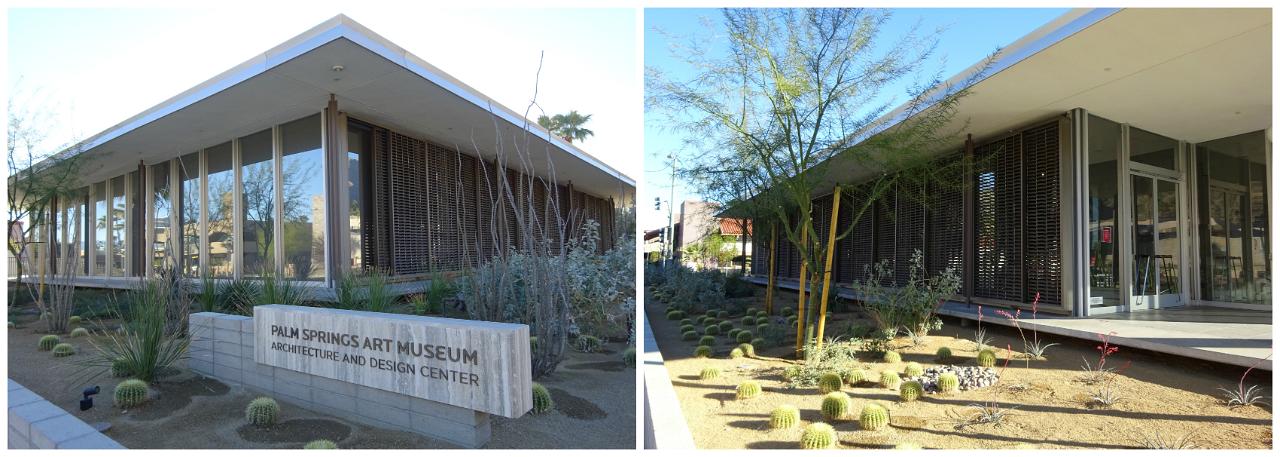
Palm Springs Architecture and Design Center, 300 South Palm Canyon Drive. Class I Historic Site No. 54
Empty and for sale for years, the Palm Springs Art Museum acquired the property and created the Design Center in 2014.
Tennis Club Neighborhood
Del Marcos Hotel, 225 Baristo Road
His first solo project, William Cody designed the angular Del Marcos Hotel in 1947 and won the American Institute of Architects Design award.
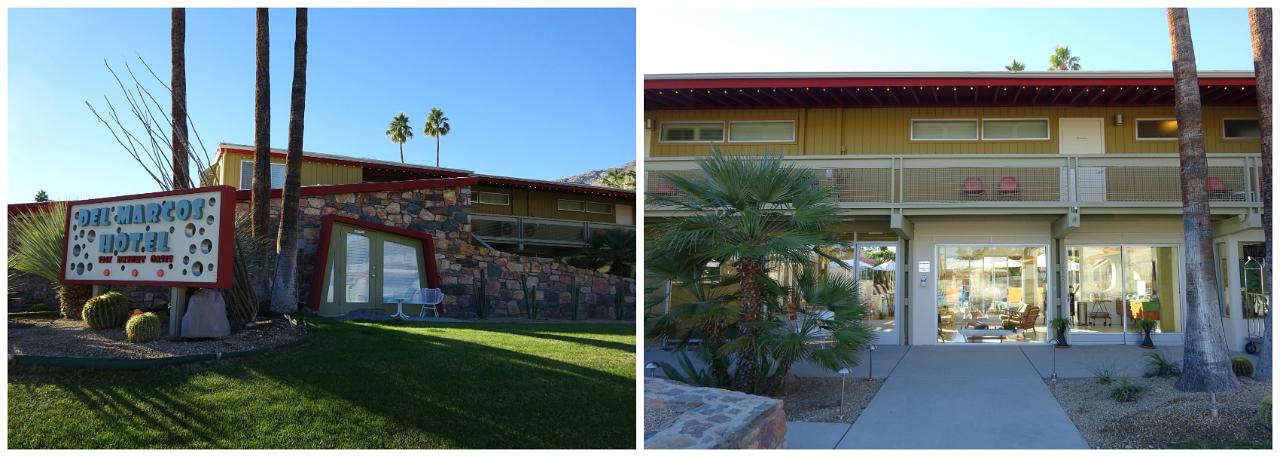
Del Marcos Hotel, built of native stone and redwood; Glass enclosed lobby
The Del Marcos features a bold angled roof and walls, stone facade, glass enclosed lobby and an open breezeway. The delightful modernist hotel was cutting edge of informal resort design in its day. Restored several years ago, it’s a popular location to get immersed in Palm Springs modernism, especially during Modernism Week in February.
Palm Springs Tennis Club, 701 W. Baristo Road
As you bike by the Tennis Club you’re going to think “Why is this famous?” It’s not the Palm Springs Tennis Club Hotel that’s the famous modern structure, it’s a 1947 addition to what was just a tennis club in the 1940’s. The addition above the pool was a joint design project by A. Quincy Jones and Paul R. Williams.
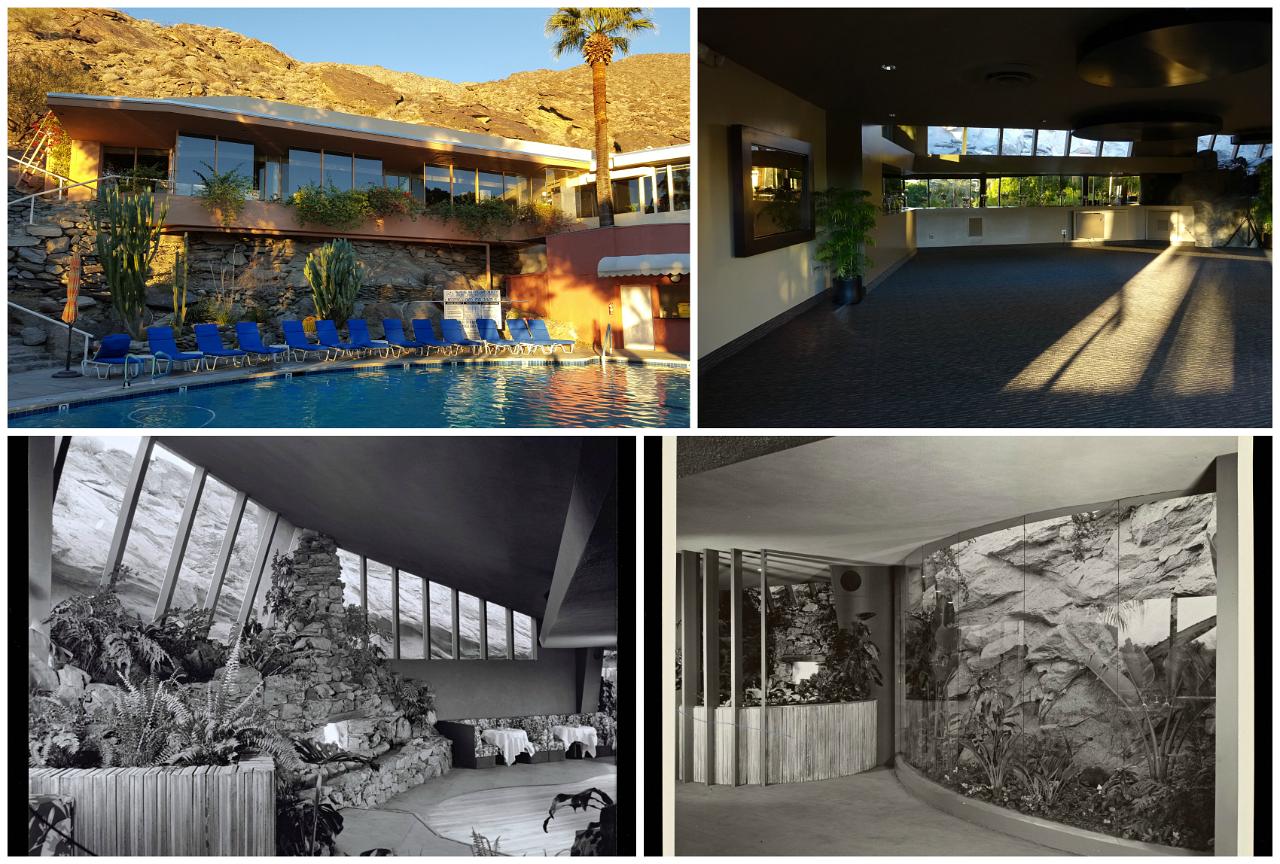
Top: Palm Springs Tennis Club addition today; Bottom: Photography by J. Shulman © J. Paul Getty Trust. Getty Research Institute, Los Angeles (2004.R.10)
The project emphasized natural wood and stone and wrap around glass tying the outdoors to the indoors. Today the building is used for functions by Spencer’s Restaurant.
Frey House II, viewed from W. Arenas Road
Bike past the Palm Springs Tennis Club over to W. Arenas Road and gaze up at two famous mid-century modern homes perched on the rocky slope. The homes are on Palisades Drive, a private drive behind the art museum.
The modest home with yellow drapes was Albert Frey’s second modernist home that he designed for himself in 1963. The roof, overhang, ceiling and walls are all of low-cost, low-maintenance aluminum with baked enamel finishes of bronze, sage green and blue – a finish that never has to be retouched. Pale yellow drapes lined with heat reflective Mylar were inspired by the yellow clusters of the California Bush Sunflower that bloom on the slopes. The interior reflects the natural surroundings outside and a huge boulder divides the living spaces.
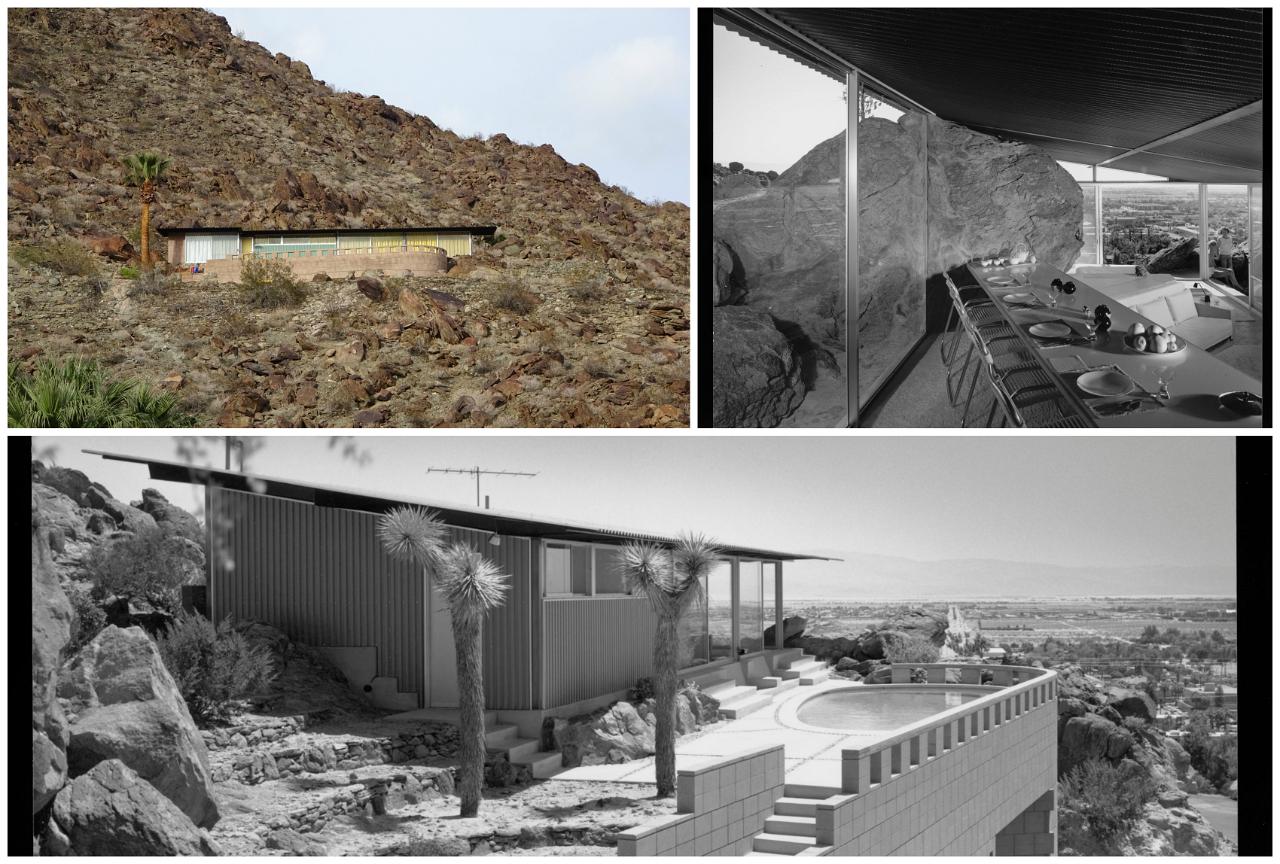
Top left: Frey House II as seen from Arenas Road; Top Right and Bottom: Photography by J. Shulman © J. Paul Getty Trust. Getty Research Institute, Los Angeles (2004.R.10)
The original 800 square foot home was expanded to 1200 in 1972. Frey lived in this home the rest of this life and bequeathed it to the Palm Springs Art Museum. If you want to see it for yourself, you can take a tour during the Palm Springs Modernism week.
The Burgess House, viewed from W. Arenas Road
The stunning glass and mirrors Burgess House, designed by Hugh Kaptur in 1957, sprawls along the rocks near the neighboring Frey House II. It took 15 years of blasting and jackhammering to turn the hillside into the desert oasis you (barely) see today.
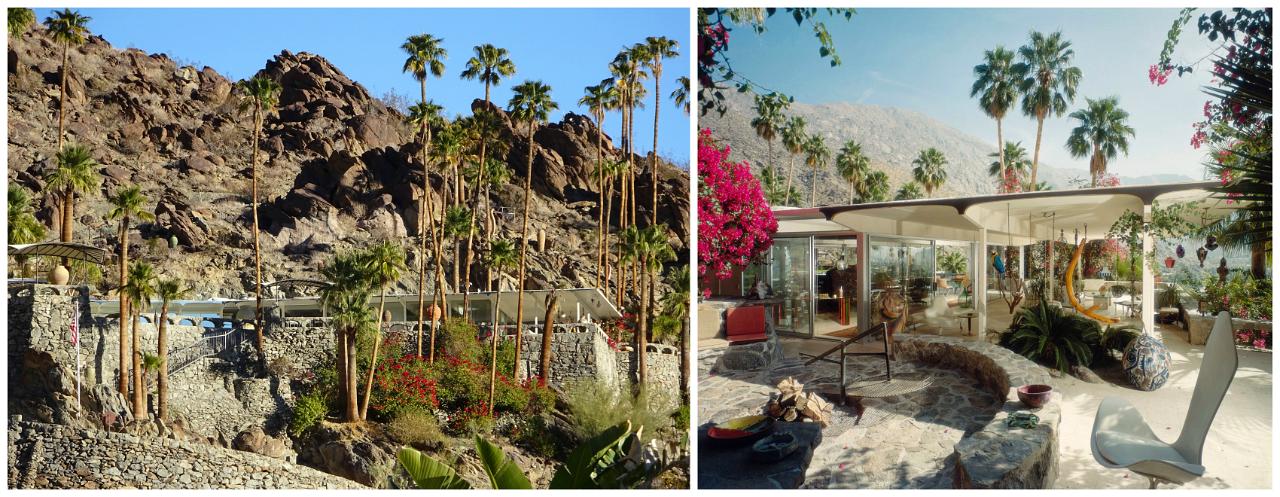
Top left: Burgess House as seen from Arenas Road; Top Right: Photography by J. Shulman © J. Paul Getty Trust. Getty Research Institute, Los Angeles (2004.R.10)
Practically invisible behind the garage is a mirrored pavilion that is a guest house, designed by Albert Frey in 1986.
The Orbit In, The 400 and The Hideaway
Now you can turn your attention from the hillside to the street level of Arenas Road. There are three properties here designed by Herbert Burns. Burns’ trademark was the use of long, thin-cut sandstone slabs, and a thin second eave and fascia below the roofline.
Orbit In, 562 W. Arenas Road
First stop, the Orbit In. Designed in 1957 by Herbert Burns, this motel was called originally called The Village Manor.
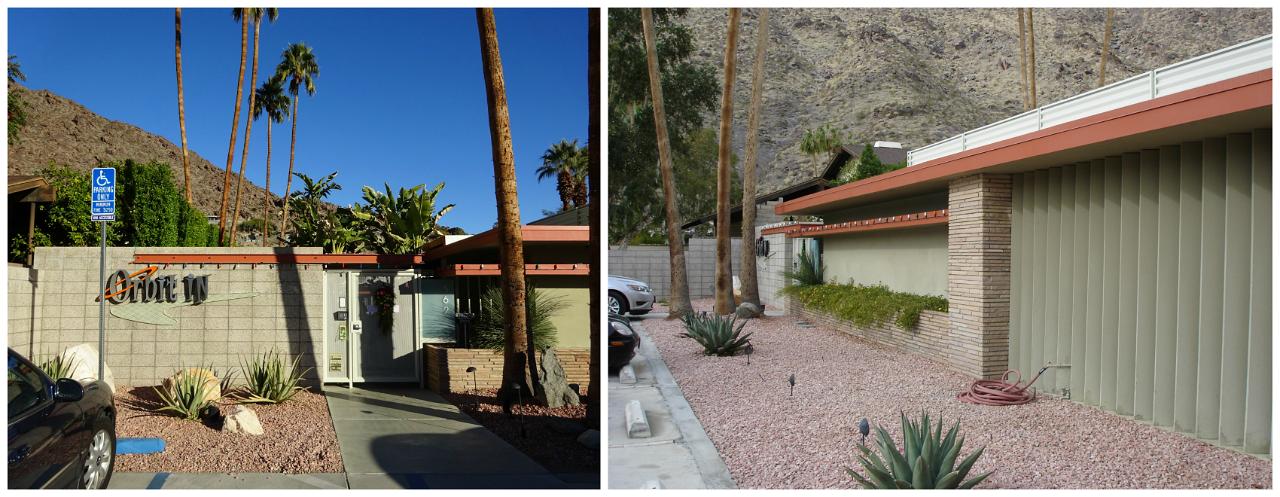
Orbit In
The Four Hundred, 400 W. Arenas Road
Up the street is The Four Hundred, apartments designed in 1956 by Burns. You can’t see anything but the sleek stone exterior. Chatting with a resident one day, he said “I don’t know what the fuss is all about, this mid-century stuff just seems like cheap 1950’s architecture to me!”
Town and Desert Apartments, 370 W. Arenas Road
Further up Arenas Road toward downtown is the Hideaway, a second property owned by the same people who own the Orbit In. Originally known as the Town and Desert, this property was Herbert Burns first Inn completed in 1947 and photographed by Julius Shulman. In the 1950’s the lawn was the setting of many civic and social events. The site is designated Class 1 Historic Site #90.

Top left and right: Town and Desert Apartments today; Bottom left: Photography by J. Shulman © J. Paul Getty Trust. Getty Research Institute, Los Angeles (2004.R.10)
Both the Hideaway and Orbit In properties were renovated in designer classic mid-century style – the Orbit In was renovated in 2001 and the Hideaway in 2002.
Palm Springs Art Museum
Zip over to Museum Drive and the impressive Palm Springs Art Museum. E. Stewart Williams designed the building in the modernist style in 1976 and also the 1996 additions.
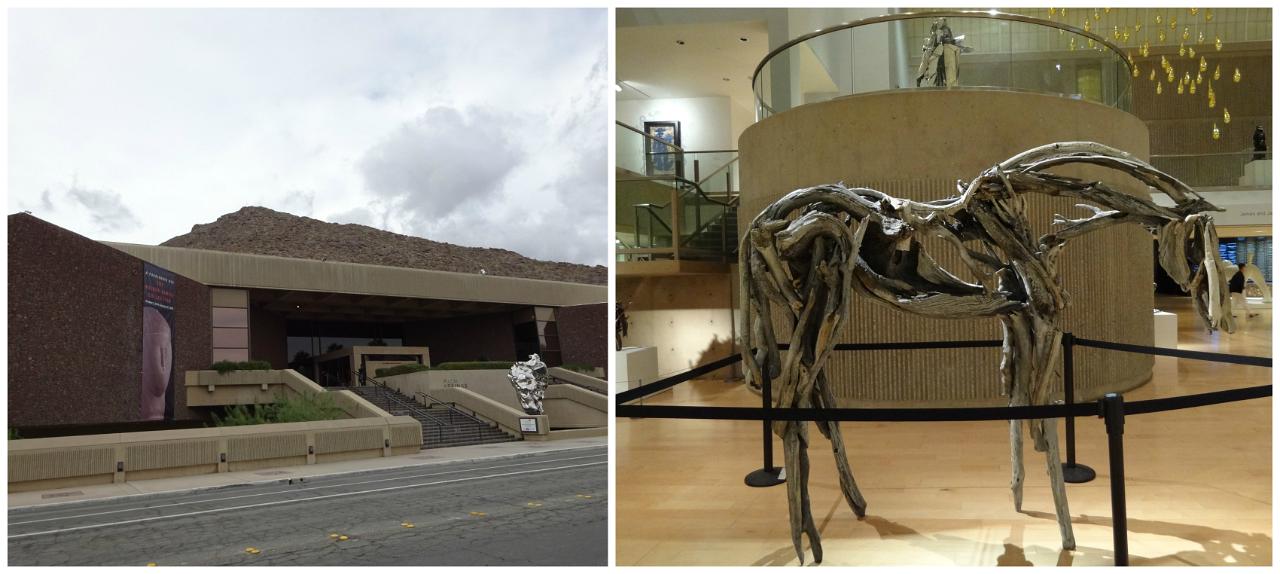
The Palm Springs Art Museum blends into the surrounding rocks; Horse sculpture made of driftwood by Deborah Butterfield
Tip: You can visit the Palm Springs Art Museum for free every Thursday between 4pm and 8pm (except holidays).
Las Palmas Neighborhood
Head past the art museum and up North Belardo Road to the beautiful Las Palmas neighborhood, a terrific place to meander around and see many mid-century modern homes. In 1958-1962 William Krisel designed many of these tract homes for the Alexander Construction Company in the area now known as Vista Las Palmas. A-framed “Swiss Miss” models are by Charles DuBois.
Follow the bike path past what used to be Liberace’s Palm Springs Home on the corner of Belardo and Alejo – the Old Las Palmas neighborhood was the first desert playground of the rich and famous back in the old Studio days…but that’s a different biking tour.
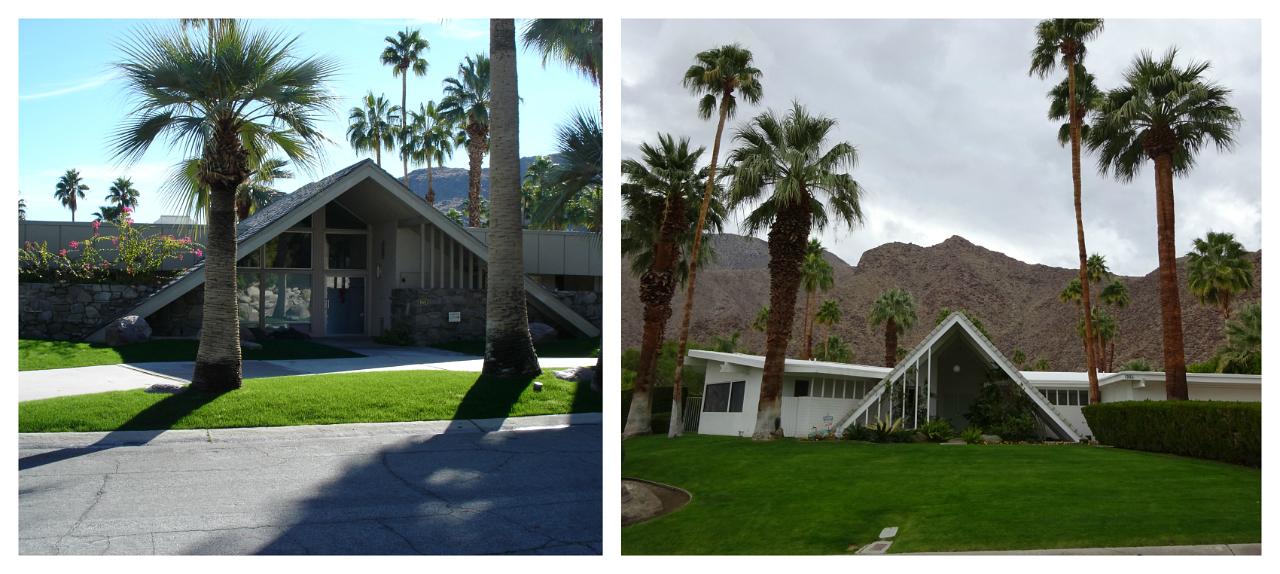
Swiss Miss A frames
House of Tomorrow, 1350 Ladera Circle
The House of Tomorrow, aka Elvis’s Honeymoon Hideaway, was a futuristic mid-century modern Alexander Construction project designed by Alexanders’ main architect William Krisel of the Los Angeles firm Palmer and Krisel, Inc.
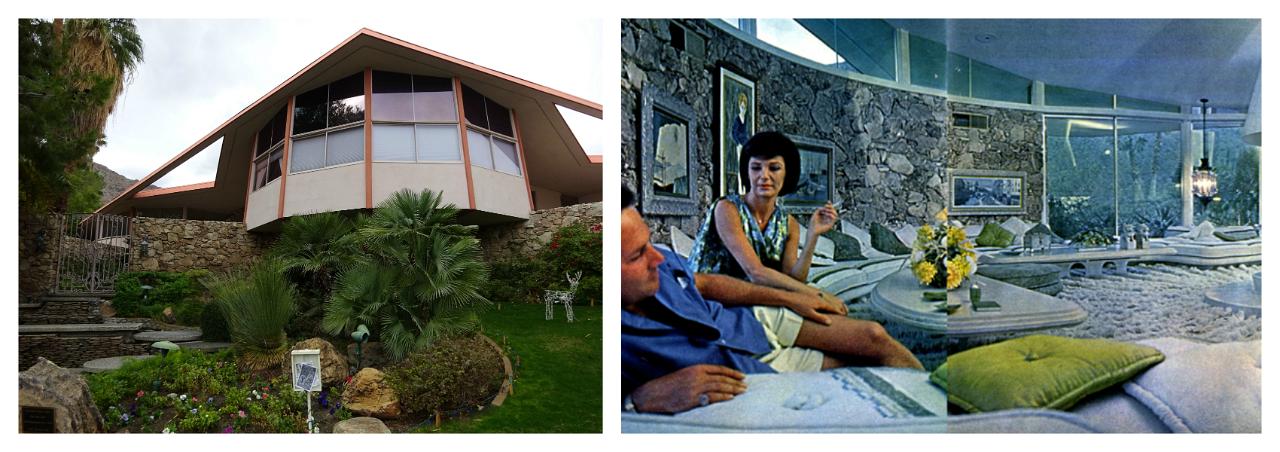
House of Tomorrow; Robert and Helene Alexander relaxing on their 64-foot built in banquette sofa www.ElvisHoneymoon.com
The house was originally built as a spec house, but Bob Alexander’s wife fell in love with the “House of Tomorrow” and she and hubby moved in. Today it’s most famous for it’s connection with Elvis who spent his honeymoon with Priscilla here.
And, yes you can even tour Elvis’s Honeymoon Hideaway.
Kaufmann House, 470 W. Vista Chino
The Kaufmann House is considered to be one of the world’s 10 most important houses. Designed by Richard Neutra in 1946 in the International style, the house was made famous by Julius Shulman’s twilight photo of Mrs. Kaufmann by the pool. That’s the photo that helped define desert modern architecture as luxurious, sensuous and serene.
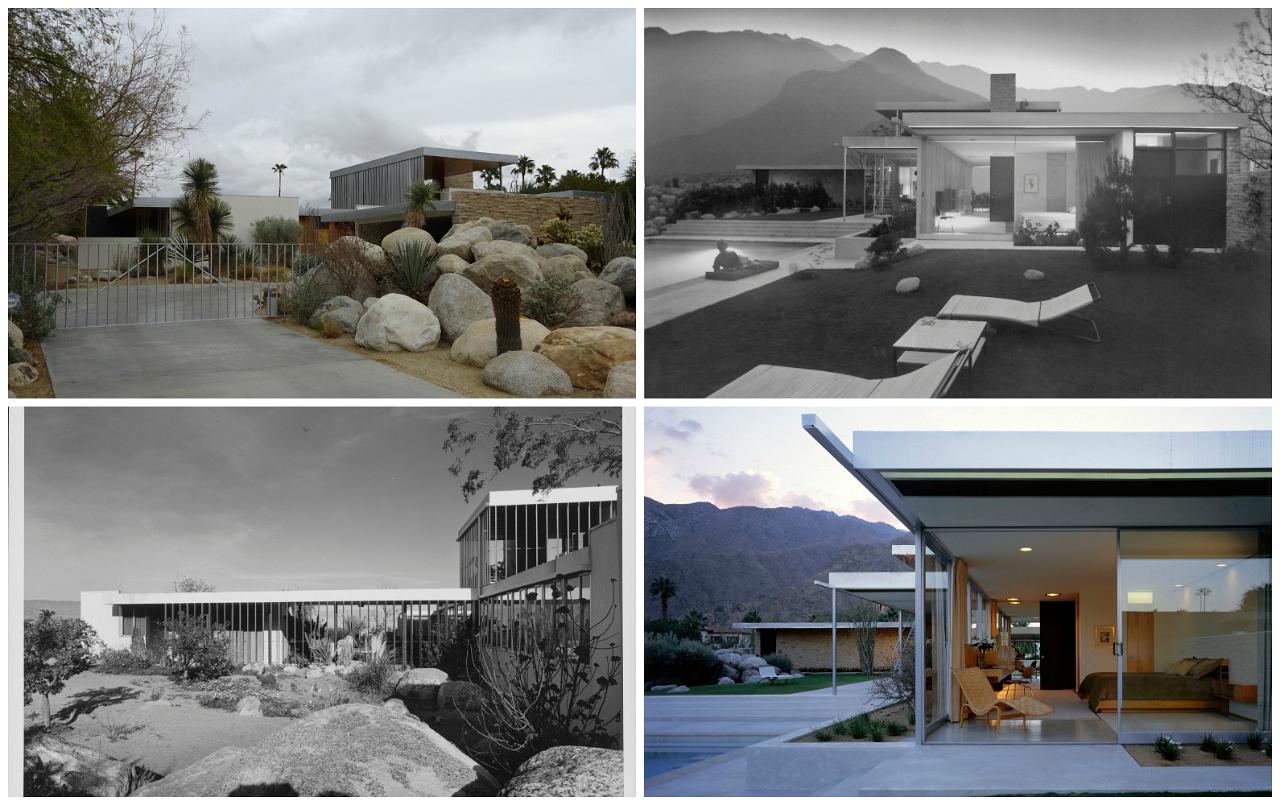
Top left: The Kaufman house that you can see from the street; Top right: Shulman’s famous twilight photo; Bottom left: Shulman’s photo of the Kaufmann house moveable fins; Bottom right: The restored Kaufmann house; © J. Paul Getty Trust. Getty Research Institute, Los Angeles (2004.R.10)
Built for Pittsburgh department store tycoon Edgar J. Kaufmann, after his death it was abandoned and vacant for years. It’s had several owners and renovations, the last was a restoration in 1991 to bring it back to it’s original design. From the street you get a tantalizing glimpse of the movable vertical fins on the upper living space that were designed to provide flexible protection from sandstorms and heat.
Edris House, 1030 W. Cielo Drive
Head up W. Chino Canyon Road, past Elvis’s second home in Palm Springs WHAT? oh yes, 845 Chino Canyon was Elvis’s for 7 years, his digs in Palm Springs complete with a recording studio. …Ride on over to Cielo Drive to see the Edris House.
E. Stewart Williams designed this home in 1954 for his friends Marjorie and William Edris. His guiding principle was that architecture should come from the earth rather than being just placed on it. The home epitomizes this concept, blending organically into the surrounding landscape.

Left: Edris House Historic site #46; Right: Photography by Shulman © J. Paul Getty Trust. Getty Research Institute, Los Angeles (2004.R.10)
During modernism week the Edris House may be open for a visit, check the Palm Springs Modernism Week website for info and tickets.
Palevsky House, Shapiro House
At the end of Cielo drive is a classic white, minimalist home designed in 1968 by Craig Ellwood. Biking back down Panorama Road, you’ll ride by the futuristic Shapiro House designed in 1969 by Michael Black.
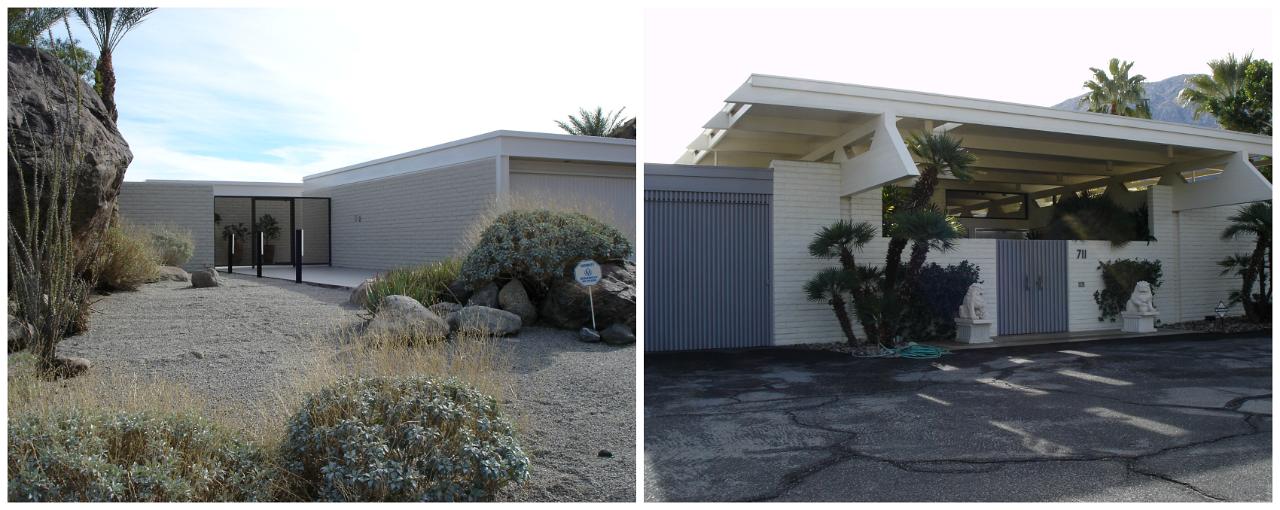
Left: Palevesky House; Right: Shapiro House
Raymond Loewy House, 600 W. Panorama Road
In 1946 Albert Frey built a house for the famous industrial designer Raymond Loewy. The house was built before air-conditioning – its indoor-outdoor pool helped to cool it from the intense desert heat.
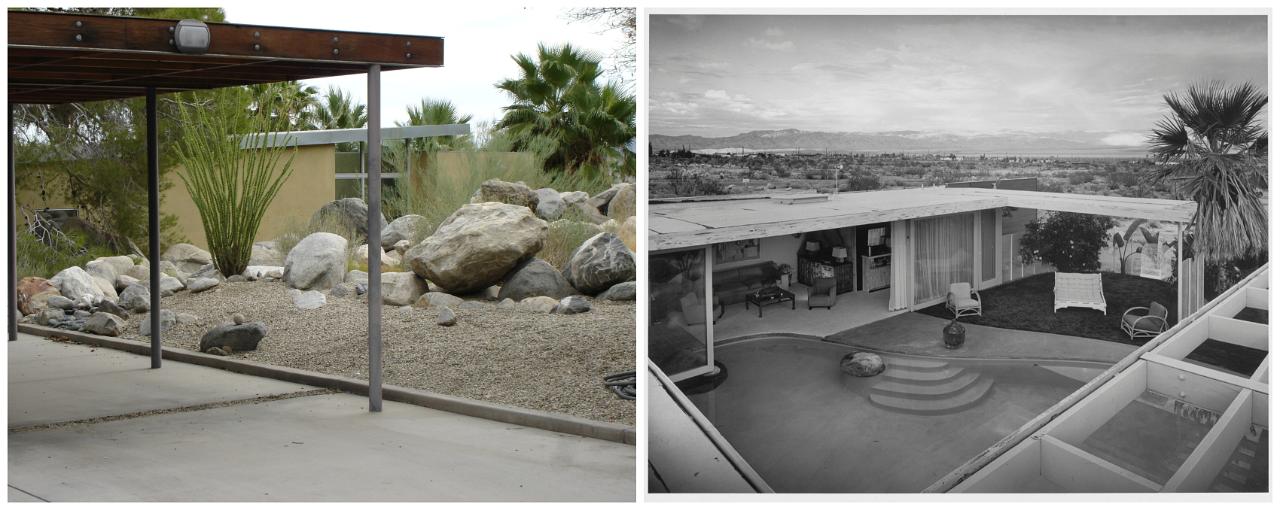
Left: A glimpse of the Loewy House from the street; Right: Photography by Shulman © J. Paul Getty Trust. Getty Research Institute, Los Angeles (2004.R.10)
Wrapping up Your Mid-Century Modern Bike Tour
It’s all downhill back to downtown Palm Springs, winding through some calm neighborhoods and over to busy Palm Canyon Drive to complete about a 7 mile loop.
After all that riding you deserve a break! Take your pick from a couple of coffee shops at Tahquitz Canyon and Palm Canyon Drive. A Starbucks holds a prime position on the corner of the Oasis Commerical Building, designed in 1952 by E. Stewart Williams.
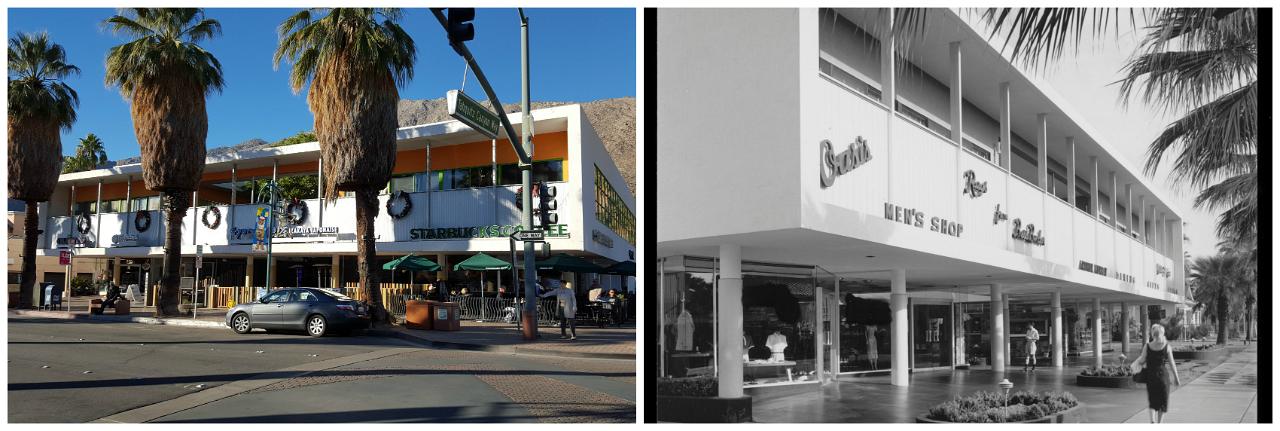
Left: Oasis Commercial Building with Starbucks on the corner; Right: Photography by Shulman © J. Paul Getty Trust. Getty Research Institute, Los Angeles (2004.R.10)
There’s plenty of modernism throughout Palm Springs to fill days of biking destinations, as you can see from my Mid-Century Modern Map. A bike ride south to see the Krisel designed Twin Palms Estates and Canyon View Estates makes a great ride, and a pedal up Tahquitz Canyon Way to see Albert Frey’s Palm Springs City Hall is easy to combine with the mid-century moderns in the Movie Colony Estates. A little farther north are the 7 famous Alexander Steel Homes designed by Donald Wexler.
If you can squeeze in a trip over to the Palm Springs Tramway, there are 3 famous buildings designed by various architects – the Tramway Visitors Center by Frey and Chambers; the Aerial Tramway Valley Station by Frey, Clark and Chambers; and if you get a ticket to the top you’ll see the Alpine station designed by E. Stewart Williams. Worth the price on a clear day for the views alone.
What do you think about Palm Springs Mid-Century Modern architecture? Would you like to live in a mid-century modern home?








Something very Mad Men-ish about those photos that suddenly made me feel old. Very interesting though, really a throwback in time. I think I especially like the Burgess House, really does look like an oasis.
Beautiful post.
Frank (bbqboy)
Frank recently posted…Bashing on full time travellers â and why âweâ bring it on ourselves
The languid poses of the Alexanders at their House of Tomorrow kind of epitomizes that Mad Men 60’s look, right? The Burgess House is one of my favorites too, imagine the commanding view over Palm Springs from that gorgeous property!
Rebecca recently posted…Daytripping in Joshua Tree National Park
Interesting photos. All gorgeous houses and properties with style. Thanks for sharing these!
I’m glad you liked the story Macs! This is still one of my top things to do when I’m in Palm Springs, I love to bike this and other routes and admire all that fun and fabulous mid-century style! Thanks for taking the time to comment.
Rebecca recently posted…3 Trails Make One Spectacular Hike You Won’t Want to Miss in Sedona